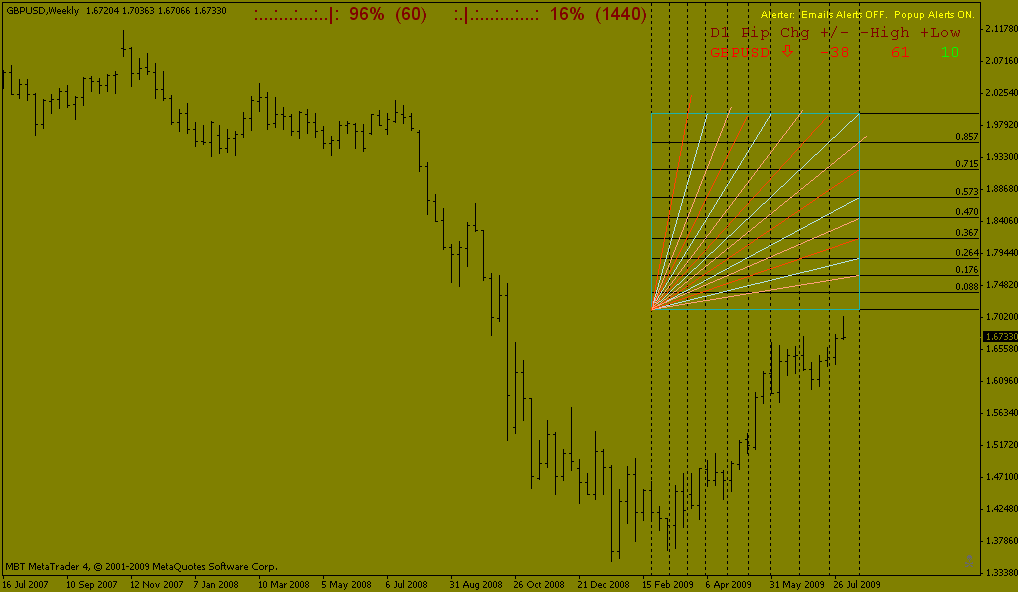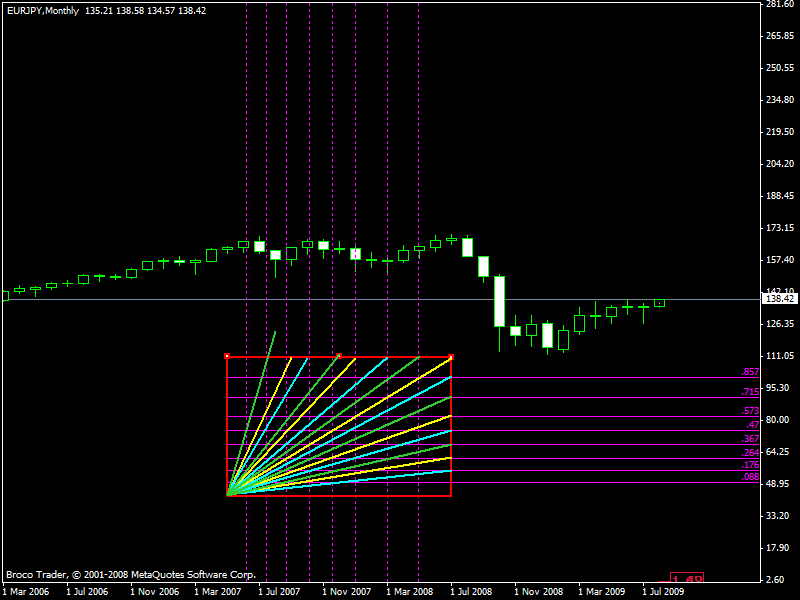now 36 pips...
Never Lose Again
Moderator: moderators
- ***FX-JEDI***
- rank: 150+ posts

- Posts: 159
- Joined: Tue Jun 09, 2009 10:48 am
- Reputation: 10
- Location: Newcastle
- Gender:

Please add www.kreslik.com to your ad blocker white list.
Thank you for your support.
Thank you for your support.
MightyOne wrote: It is difficult just to teach people how to construct a Diamond of Perception.
The first rule is that it is put together using a major angle (45* using this square method).
Then after it is constructed the scales can change and the major angles that you saw working so well on the last scale are then carried over to the new scale.
I was less than happy with the margin of error when drawing an angle between sharps and flats so I did it right by completing the fibo and using the same numbers between 0 & 1 for the Fibo TimeZone tool.
Construct the major angles first and then add in the sharps and flats using the fibo/fibo tz:
I can see you doing

already, but it is no difficult:
Thanks for this new way with the Fibo Time Zones.
I was just playing around with the boxes to see if they're the same kind/size of boxes that capture corrections (that you talked about a while ago). Based on that I created this chart. I don't know if this is where we're headed but wow! there are some patterns going on here.
- Attachments
-
- 080709_gbpusd_diamond.gif (27.85 KiB) Viewed 4879 times
- Patch
- rank: 500+ posts

- Posts: 941
- Joined: Sat Jan 06, 2007 6:13 pm
- Reputation: 0
- Location: Virginia
- Real name: Jeff
- Gender:

- Contact:
FX-JEDI
Have a great time camping! Where abouts are you camping? Are you stationary or backpacking?
Great posts, and very helpful explaination. Many thanks, Patch
Have a great time camping! Where abouts are you camping? Are you stationary or backpacking?
Great posts, and very helpful explaination. Many thanks, Patch
ENOUGH being a Yalie for me Back to the Sea. "What i can lose, i can win" "YES YOU CAN" - dragon33 -"Pick one method and one pair and stick with them until you master it. "The choice is yours - success or failure." TRO
- aVi
- rank: 50+ posts

- Posts: 84
- Joined: Tue Mar 24, 2009 4:30 am
- Reputation: 0
- Location: The Island w/ Kate
- Gender:

As soon as we start to figure things out, MO shows us how much we still have to learn. Running the risks of complete embarrassment, seeing as I still feel a bit clueless about this, here is my first attempt. Don't laugh. You may point, just don't laugh... 




...I'm off to see the wizard.



...I'm off to see the wizard.
Wake up Mr. Green...
- ***FX-JEDI***
- rank: 150+ posts

- Posts: 159
- Joined: Tue Jun 09, 2009 10:48 am
- Reputation: 10
- Location: Newcastle
- Gender:

Patch wrote:FX-JEDI
Have a great time camping! Where abouts are you camping? Are you stationary or backpacking?
Great posts, and very helpful explaination. Many thanks, Patch
Thanks mate..
yeah am mate, I am close to home only about 15min from home actually, on the beach at stockton caravan park, have only 2 hrs of free wireless internet from the park each day, been here 3 weeks. go home this weekend, after my little girls 1st birthday party on sunday, but her birthday actually on monday 10th.
I rebuilt a 17ft 70's model caravan from the chassis up, so all brand new, gloss white inside and out..lol, but just old school...lol closest thing I could get wife to camping...
got out of trade with 34 pips got out bit early, then was going to short it down back to 1.4300 but too tired & past it up...
nite all..
Its better to be out of the market wishing you were in,
then being in the market wishing you were out.....
then being in the market wishing you were out.....
Please add www.kreslik.com to your ad blocker white list.
Thank you for your support.
Thank you for your support.
- Patch
- rank: 500+ posts

- Posts: 941
- Joined: Sat Jan 06, 2007 6:13 pm
- Reputation: 0
- Location: Virginia
- Real name: Jeff
- Gender:

- Contact:
I like sleeping in hotels or vans. The ground has gotten harder over the years. My wife loves going out camping, even to the point of tents and sleeping on the ground. jb
ENOUGH being a Yalie for me Back to the Sea. "What i can lose, i can win" "YES YOU CAN" - dragon33 -"Pick one method and one pair and stick with them until you master it. "The choice is yours - success or failure." TRO
-
Who Am I ?
- rank: <50 posts

- Posts: 17
- Joined: Fri Jul 31, 2009 1:56 pm
- Reputation: 0
- Gender:

- razorboy
- rank: 500+ posts

- Posts: 627
- Joined: Tue Oct 21, 2008 2:06 am
- Reputation: 0
- Location: Toronto
- Gender:

- Contact:
or you can just figure out how to double your money with 25% win rate...........
MightyOne wrote:monolisa wrote:Thanks, MO.
I wonder how the method could be put into practical use.
I can see how the pip value of angles is calcuated. However, how do we know the future angle value when the trend changes? The angle is usually confirmed later when the trend materialise and at that moment a number of bars has been passed.
I also notice you draw the upper left corner of the box at the 1st retracement of the trend. Is it correct?
Thanks.
Lis
The only thing that matters is that the angle connects the points of the box....
it really does not matter where you start drawing the box as you only wish to define the degrees so that the angles can be used on any scale.
The exact angles do not matterthe proportions do.
There is a margin of error of 5* when drawing Major angles; these "errors" are known as sharp and flat angles.
35 & 25 degrees is considered to be a 30 degree angle.
You do not have to wait for a "trend" before the angles of ascent and decline are known.
The charts follow very predictable patterns which, when recognized, cause your risk to combust
Ya, I manufacture clear shoe boxes.....http://www.clear-shoe-boxes.com.............who would have thunk!
http://thejoshkerbelproject.com/
http://thejoshkerbelproject.com/
Please add www.kreslik.com to your ad blocker white list.
Thank you for your support.
Thank you for your support.


